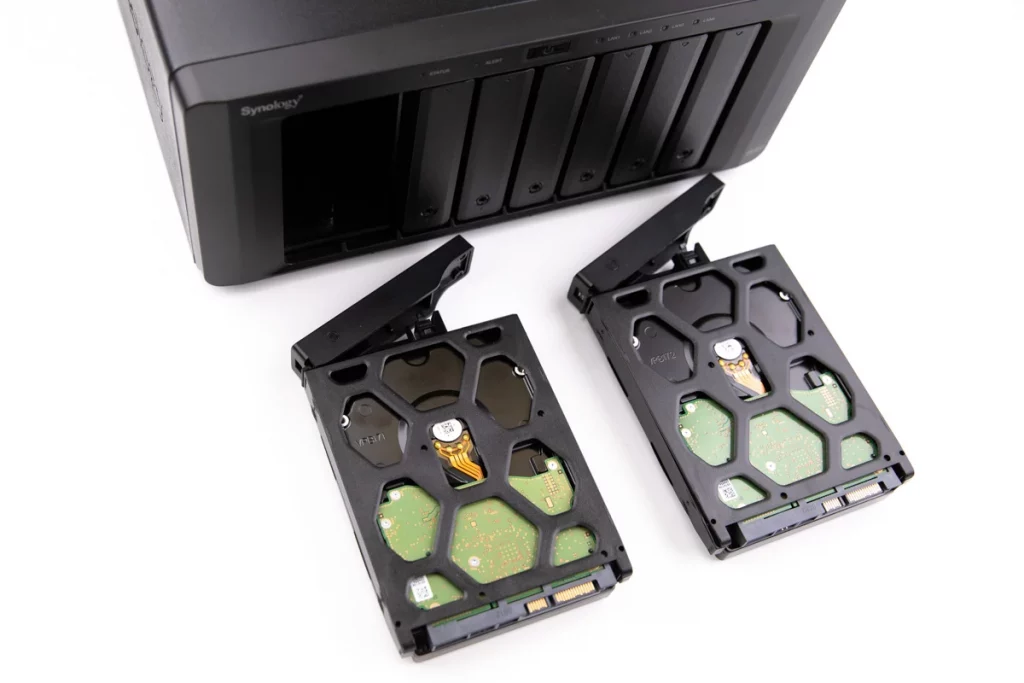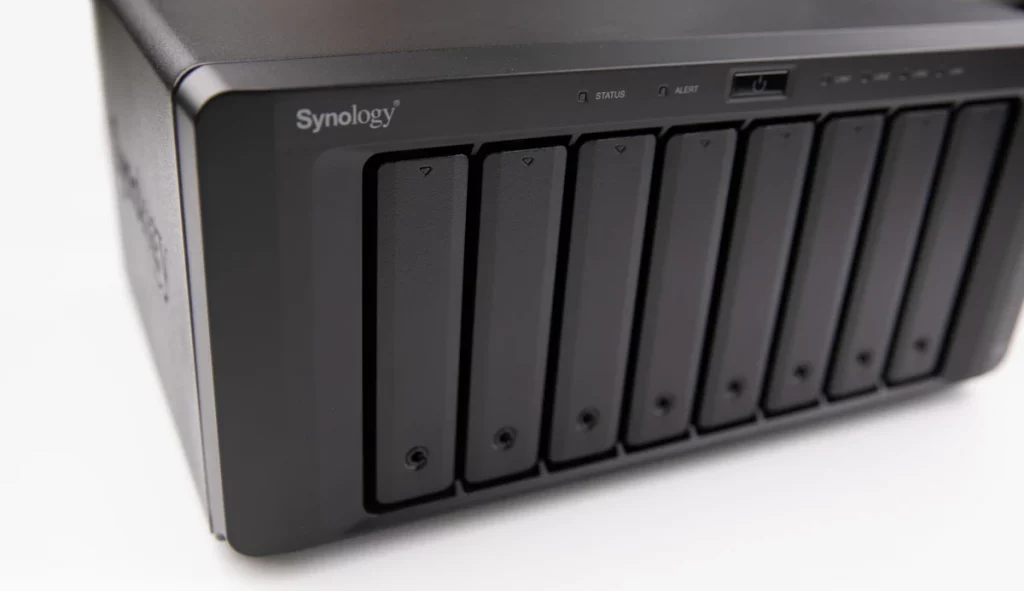A Redundant Array of Independent – RAID – is a data storage system used by enterprises all over the world. It consists of a group of hard drives joined to the network to ensure data accessibility. RAID earned a reputation as a reliable way to store confidential data and, therefore, is used in servers, NAS, and SAN devices.
Nevertheless, Redundant Arrays of Independent Disks are not error-free and are susceptible to failures and consequent data loss. There are several reasons for data loss, many of which result from the RAID infrastructure.
A RAID has a complex structure. When something is wrong with the system, all the data stored on the device will become inaccessible. Hence, a data loss on RAID results in severe problems not only for one employee but for the whole business.
The Reliability of RAIDs
The reputation of a Redundant Array of Independent Disks is earned by their high storage capacity, data security, fault tolerance, and excellent performance. In addition to these benefits, some levels of RAID deliver protection of sensitive data against data loss.
Due to the mirroring system on RAID, it becomes more manageable to avoid a complete data loss situation. The chances of significant disaster are decreased with this technique.

Still, it does not mean the complete data loss is 100% avoidable. However, it is critical to mention that simultaneous failure of the drive is always possible, so complete inaccessibility of your files is unavoidable.
Thus, the storage provides its reliability with a mirroring system but does not guarantee complete fault-free performance. The RAID often does not show any signs of malfunction, so the situation worsens without the user’s noticing.
A RAID storage system is entrusted to operate on a large amount of data. Hence, the chances of failure must be eliminated entirely. This can be achieved by performing regular scans of your device. Noting the signs in time can also assist you in preventing data loss.
Signs of RAID Failure
It is of utmost importance to identify the warning signs of RAID failure early on to prevent data loss and take corrective measures on time. The following are some common indications to be aware of:
Data Inaccessibility
A RAID failure could be the reason for difficulty accessing your data or files. This problem can manifest in different ways, such as missing files, corrupted data, or the entire volume becoming inaccessible.
Slow Read/Write Speeds
A significant decrease in read and write speeds, even with low data loads, can indicate impending RAID issues. Sluggish performance may predict disk failures or other problems within the array.
Unusual Noises
Unusual sounds such as clicking, grinding, or other distinct noises from your RAID drives are a warning sign. These noises could indicate hardware difficulties inside the drives.
RAID Array Degraded
Status indicators are often available on RAID systems. If you observe a change in the RAID status to “degraded” or “critical,” it indicates the presence of failed or problematic drives.
Error Messages
Watch for error messages or notifications from your RAID controller or management software. These messages can provide valuable information about the nature of the problem.
Missing Drives
A clear indication of a problem is when the RAID controller fails to recognize one or more drives in the RAID array or if they seem missing from the system.
Frequent Crashes or Freezes
Regular system crashes freezes, or unexpected reboots can result from RAID failure, particularly during disk-intensive operations.
SMART Warnings
Self-monitoring, Analysis, and Reporting Technology (SMART) is a feature built into many hard drives. If the SMART feature detects any warnings or errors, it could indicate a potential hard drive failure.
Once you notice any of these indications, it is crucial to act promptly and diagnose and correct the RAID malfunction. Quick action can frequently avoid data loss and reduce downtime. You may have to substitute defective drives, reestablish the array, or obtain professional assistance from data recovery specialists, depending on the issue’s severity.
The Reliability of RAIDs
Partition Loss
Due to the errors within a RAID array, a disappearance of partition with the system may occur. It often occurs due to a virus attack, hardware or software error, power surge, and bad sectors. Users can cause partition loss by replacing a failed hard drive with a new one, which will bring no good results.
Frequent Error Messages
Facing error messages on your RAID array can not be an indicator of clean performance. On the contrary, it is considered one of the most apparent warning signs for a user. Errors while trying to read or write data highlight a problem within your RAID system, which can later result in a disaster.
Controller Issues
RAID controller, a storage hardware component, may become faulty due to problems within the system. This issue occurs with a wrongfully performed RAID rebuild or hard drive failure. RAID will fail to detect the partitions, and the controller will not perform properly. Hence, data loss can be noted by the user.
Data Corruption
Data corruption is a common symptom of an issue within the RAID system. It mostly occurs due to the bad sectors that appear on the hard drive due to wear and tear. Data corruption can also be caused by the malware inserted on the device, as it starts to spread throughout the system making the files inaccessible
How to Fix RAID Failure
Facing a malfunction on a Redundant Array of Independent Disks can be critical for any user. Therefore, to avoid all the severe consequences, many people try to fix the array themselves. However, it often decreases the chances of successful recovery from RAID. There are several steps a user should go through several steps.

It is critical not to rebuild the RAID yourself, because data loss after RAID rebuild is highly possible. Using RAID recovery software on the device is also not recommended. When installing a recovery tool, there are several risks, including viruses and overwriting.
Hence, to solve your problem at the earliest opportunity, entrust your RAID to a professional data recovery company.
PITS Global Data Recovery Services is a trustworthy provider of solutions for RAID data repair. We offer an extensive set of services for businesses and individuals throughout the United States. Our engineers specialize in enterprise-level devices and recover data from the RAID of any configuration.
Advantages of Our Services
Why Choose Us
PITS Global Data Recovery Services delivers premium data recovery solutions with a focus on quality and individual care for every case. As a DUNS-verified business, we are committed to excellence, ensuring 100% customer satisfaction. Our tailored service options suit a range of recovery needs and budgets. For critical situations, we offer emergency data recovery, restoring data quickly and reliably without compromising quality.

If you’re facing a data loss situation, don’t hesitate to contact us. Our 24/7 data recovery services are available to you, 365 days a year. Let us help you recover your precious data today.

We start the recovery process with a risk-free evaluation. Our technicians estimate reasons for data loss and the level of damage. Based on it, we select the most suitable recovery strategy.

With years in the data recovery industry, our company supports the highest customer satisfaction rate. We do everything to provide a positive experience for our clients.

During our remote customer file verification session, you will thoroughly review all necessary documents and records to ensure accuracy and compliance.

We offer data recovery services from over 50 locations across the US. This means that no matter where you are located, you can access our services to recover the data.

With our certified data recovery services and 99% success rate, we are confident that we can recover your precious data and get you back up and running in no time.
With more than 50 drop-off points and offices throughout the country, we are ready to help our clients anywhere and everywhere they are. Hence, when facing a failure on RAID, you can quickly approach one of our locations in your city and state.
After receiving your device at our lab, we will perform a risk-free evaluation. With an assessment, our engineers will thoroughly review the RAID, estimating the reason for data loss, level of damage, and chances for successful recovery. This way, we can select the most suitable method for your case.
After estimating the recovery strategy, we start working on your RAID in specialized facilities. Working in ISO Certified Class 10 Cleanroom, we protect the media from external threats. Safely restoring your valuable data from RAID, we achieve the maximum possible result.
After the recovery process is completed, we perform a verification session to ensure that all the high-priority data is restored. When a client approves the recovered files, we send them and ensure that they have been received.
Start your RAID failure recovery process with our skilled specialists today by filling out the form below or calling our customer service line. We will gladly help you restore all the valuable files from your RAID.
Frequently Asked Questions
What are some common symptoms of RAID array failures?
Typical symptoms of RAID array failures contain data corruption or loss, error messages during boot-up, slow or degraded system performance, missing or inaccessible files, and audible warning signals from the RAID controller.
How often does RAID fail?
The frequency of RAID failures can vary relying on several aspects, including the RAID level, the quality of hardware components, and maintenance practices. While RAID arrays are designed to deliver fault tolerance, they are not resistant to failures. Routine maintenance, monitoring, and proactive replacement of aging hardware can help decrease the possibility of failure.
How do I know if RAID is working?
RAID management software or tools from the RAID controller can be used to verify if your RAID array is operating correctly. Check the status of each drive in the array to confirm they are operational and look for any error messages or warnings. Additionally, conduct periodic data integrity checks and monitor for any unexpected performance degradation or data loss, as these can be indicators of RAID issues.
Why does RAID fail?
RAID can fail for different reasons, including hardware failures (such as a failed hard drive), human errors (like accidental deletion of data), controller failures, power surges, or firmware/software issues. RAID configurations with lower levels of redundancy (e.g., RAID 0) are more susceptible to failure, while higher RAID levels (e.g., RAID 1, RAID 5, RAID 6) provide better fault tolerance. Proper maintenance, regular backups, and monitoring can help mitigate the risk of RAID failure.


